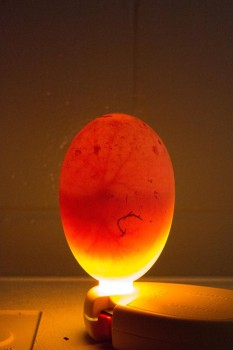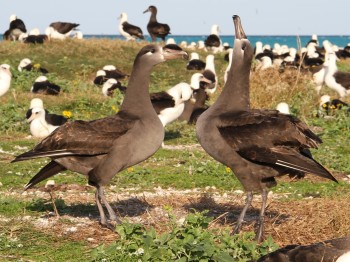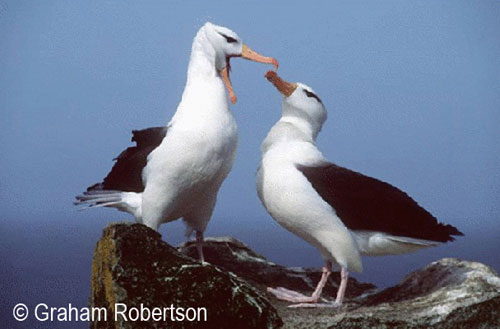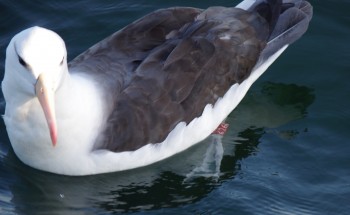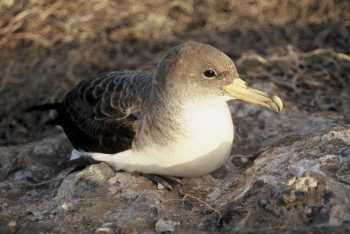ACAP Latest News has regularly reported on the parlous state of Tristan Albatrosses Diomedea dabbenena on Gough Island in the South Atlantic whose downy chicks are attacked and killed by introduced House Mice Mus musculus every year, leading to a low and non-sustainable breeding success (click here). More recently such behaviour has been reported for mice on sub-Antarctic Marion Island where four species of albatrosses are at risk (click here).
News is now in that similar attacks, this time on incubating Laysan Phoebastria immutabilis and Black-footed P. nigripes Albatrosses in the Northern Hemisphere, are taking place on the USA’ s Midway Atoll.
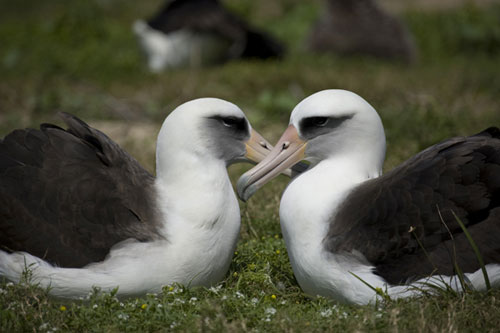
Laysan Albatross pair, photograph by James Lloyd
The press release from the U.S. Fish & Wildlife Service is reproduced here in its entirety.
“Scientists Document Non-native Mice Attacking Nesting Albatrosses at Midway Atoll National Wildlife Refuge
Amongst the more than 480,000 nests of the world’s largest albatross colony, U.S. Fish and Wildlife Service biologists and volunteers recently discovered house mice attacking adult nesting Laysan and black-footed albatrosses at Midway Atoll National Wildlife Refuge, part of Papahānaumokuākea Marine National Monument. Mice attacks have been documented at other islands, on other seabirds, but never at Midway on the large albatrosses. An albatross stands almost three feet tall with a wingspan of more than six feet and has a deeply ingrained drive to steadfastly incubate its egg through adversity. This evolutionary strategy is successful for withstanding fierce north-Pacific winter weather and aggressive neighboring birds, but leaves the albatross extremely vulnerable to non-native, predatory rodents. As Midway’s albatrosses faithfully incubate, many are now being bitten and preyed upon by non-native mice during the night – causing debilitating injuries and often death.
This phenomenon was first observed at the end of December 2015 when Refuge scientists and volunteers found open wounds on the backs, necks, and heads of nesting albatrosses in a small area on Sand Island, Midway Atoll. Using automatic cameras, live traps, and laboratory examination of bite marks on mortally-wounded birds; scientists rapidly identified the cause of the injuries as attacking non-native house mice. Since then, more than 300 nesting adult albatrosses are known to have been attacked and the mouse aggression has spread to 2 additional areas in the seabird colony. Forty-eight bitten birds are known to have died and at least 46 nests have been abandoned. Death is believed to come from infection in the open wounds, as well as severe stress to the birds as mice chew at them persistently throughout the night. “Wisdom”, the world’s oldest known wild bird, is nesting roughly ¾ of a mile away, far from the mice-attack zones.
“The Service is working against the clock to determine how many birds have been attacked, what the rate of spread is, and how to stop the attacks,” reported Bob Peyton, Manager of Midway Atoll Refuge. “Albatrosses lay only one egg a season and those eggs are hatching now. Our short-term objective is to eliminate mouse predation on the albatrosses before other mice learn this behavior and attack and kill more adults and chicks.”
House mice (Mus musculus) are not native to Midway Atoll and were inadvertently introduced to the atoll decades ago. Mice coexisted amongst the millions of seabirds that nest on the ground, in burrows, and in trees at Midway without obvious conflict most years. Refuge managers and scientists are uncertain what created the current dramatic and grisly change in mouse behavior but ground-nesting seabirds have not evolved behaviors to protect themselves from rodent predation.
“I have been working in the Pacific for over 25 years and this is an entirely new and debilitating phenomenon that I haven’t witnessed before,” noted Dr. Thierry Work a Wildlife Disease Specialist from the U.S. Geological Survey Wildlife Health Center.
Refuge managers are working with a team of rodent control and wildlife experts to develop and deploy strategies to suppress mouse population levels in order to stop the attacks or minimize their incidence. With thousands of albatross chicks hatching out of their eggs daily on Midway over the next month, the Service and partners are determined to preserve and maintain suitable predator-free habitat where albatross parents can adequately protect and raise their chicks.”
Albatross eggs are hatching now in the Northern Hemisphere. It remains to be seen if the Midway mice will switch to attacking chicks during the brood and guard stages, and once they are left on their own, as happens on Gough and Marion.
With thanks to Peter Ryan for the link.
Selected References:
Davies, D., Dilley, B.J., Bond, A.L., Cuthbert, R.J. & Ryan, P.G. 2015. Trends and tactics of mouse predation on Tristan Albatross Diomedea dabbenena chicks at Gough Island, South Atlantic Ocean. Avian Conservation and Ecology 10(1): 5. http://dx.doi.org/10.5751/ACE-00738-100105.
Dilley, B.J., Schoombie, S., Schoombie, J. & Ryan, P.G. 2015. ‘Scalping’ of albatross fledglings by introduced mice spreads rapidly at Marion Island. Antarctic Science doi.org/10.1017/S0954102015000486.
Kepler, C.B. 1967. Polynesian Rat predation on nesting Laysan Albatrosses and other Pacific seabirds. The Auk 84: 426-430.
John Cooper, ACAP Information Officer, 09 February 2016

 English
English  Français
Français  Español
Español 